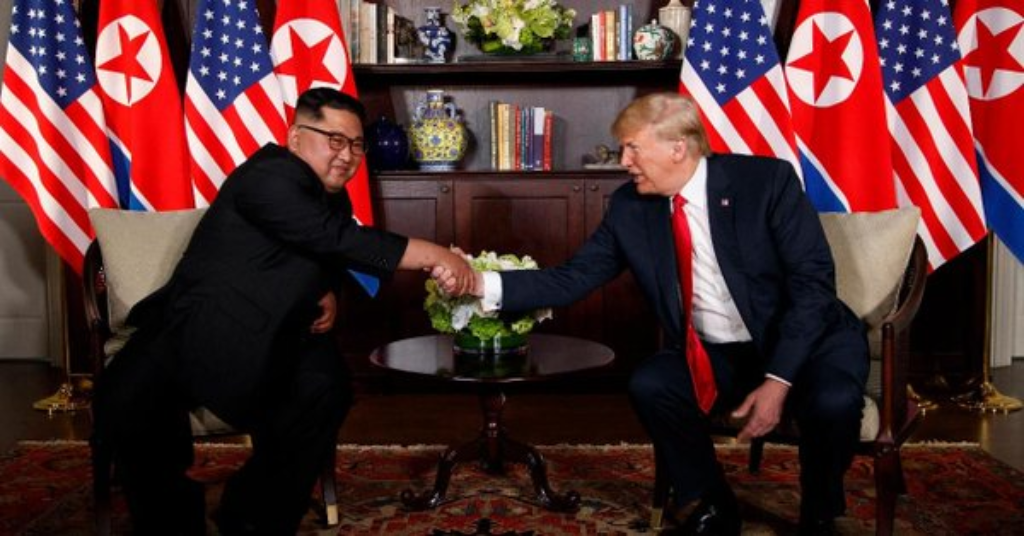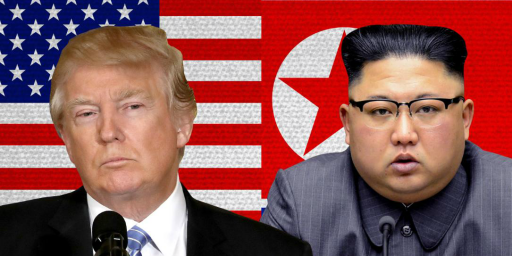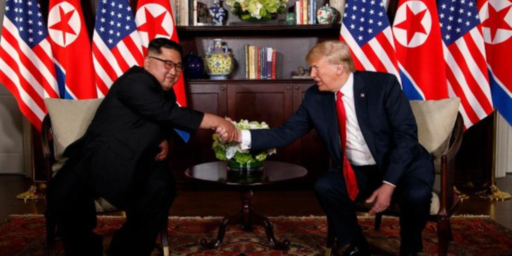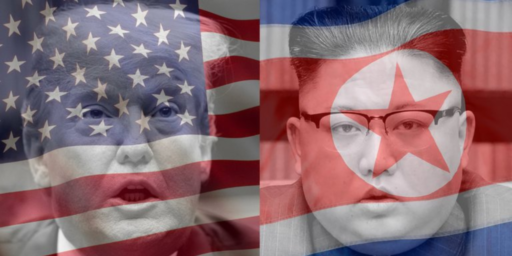Despite Singapore Summit Hype, North Korea Is Still Making Nuclear Weapons
Three months after the Singapore summit, evidence grows that North Korea is still making nuclear weapons.

NBC News is reporting that, despite the Administration’s previous claims regarding a breakthrough with North Korea, the DPRK is still making nuclear weapons:
As President Donald Trump issues a steady stream of praise for Kim Jong Un in interviews and on Twitter, a steady stream of evidence that North Korea is still making nuclear weapons has pushed his administration to take a much more aggressive stance toward Pyongyang.
The newest intelligence shows Kim’s regime has escalated efforts to conceal its nuclear activity, according to three senior U.S. officials. During the three months since the historic Singapore summit and Trump’s proclamation that North Korea intends to denuclearize, North Korea has built structures to obscure the entrance to at least one warhead storage facility, according to the officials.
The U.S. has also observed North Korean workers moving warheads out of the facility, the officials said, though they would not speculate on where the warheads went.
One former senior U.S. official said North Korea frequently moves equipment around to hinder foreign intelligence gathering. “They’re trying to move them around so our sensors are confused,” the official said.
U.S. intelligence assesses North Korea could produce five to eight new nuclear weapons in 2018, according to three current and former senior U.S. officials. That pace is virtually identical to their assessment of the regime’s production of about six per year prior to the Trump-Kim summit.
Bruce W. Bennett, a senior international/defense researcher at the RAND Corporation and an expert in Northeast Asia military affairs, agrees with that assessment of the pace of production.
“Since the beginning of 2018, Kim has surrendered and dismantled no nuclear weapons, but has likely built five to nine new nuclear weapons. So he has not frozen his nuclear program and he has certainly not been denuclearizing; instead, he has been nuclearizing.”
The Trump administration has launched what it calls a “maximum pressure” campaign against North Korea in response.
(…)
On Sunday, North Korea held its annual Foundation Day military parade to commemorate the 70th anniversary of the founding of the nation on Sept. 9. In past years, the Kim regime has used the parade to show off missiles and new technology.
This year, however, North Korea did not display any ICBMs. On Twitter, Trump said “experts” were heralding the absence as a sign of the Kim regime’s “commitment to denuclearization.” He thanked Kim and called the lack of missiles a “very positive statement.”
“We will both prove everyone wrong! There is nothing like good dialogue from two people that like each other!”
A spokesperson for the National Security Council said, however, that Trump is personally directing the pressure campaign against North Korea. “The president closely directs every aspect of the administration’s DPRK policy including the negotiations and the pressure campaign. He is clear-eyed about the challenges and sees this as a unique and fleeting opportunity to use diplomacy to achieve our objectives.”
But North Korea’s recent actions have challenged the Trump team’s pressure campaign, and now the administration is looking for ways to bolster it.
The first sign of the shift will be at sea, officials said, where an international maritime coalition will step up its efforts to expose ships and nations that are evading sanctions with illegal transfers of goods between ships at sea, according to three senior U.S. officials.
If you read the President’s Twitter feed, you wouldn’t know this is happening:
North Korea has just staged their parade, celebrating 70th anniversary of founding, without the customary display of nuclear missiles. Theme was peace and economic development. “Experts believe that North Korea cut out the nuclear missiles to show President Trump……
— Donald J. Trump (@realDonaldTrump) September 9, 2018
…its commitment to denuclearize.” @FoxNews This is a big and very positive statement from North Korea. Thank you To Chairman Kim. We will both prove everyone wrong! There is nothing like good dialogue from two people that like each other! Much better than before I took office.
— Donald J. Trump (@realDonaldTrump) September 9, 2018
All of this comes just a couple days before we hit three months since President Trump and North Korean leader Kim Jong Un met in Singapore for a much-hyped summit meeting.
While the Administration in general the President in particular walked away from that summit claiming that great progress had been made, a mood perhaps best capped off by the President’s proclamation that North Korea was no longer a nuclear threat to the United States, the reality of what has actually occurred is far more complication. On the positive side, I suppose, there’s the fact that the two nations are continuing to meet with each other rather than hurl heated rhetoric at each other via the DPRK’s state television network and the President’s Twitter feed. As Winston Churchill once put it, it is better to jaw-jaw than to war-war. The main forum for those meetings have been discussions between Secretary of State Pompeo and Kim Yong Chol, a General who serves as the Vice Chairman of the DPRK’s Communist Party, acting as the chief North Korean diplomat, although the North Koreans have complained about what they call a “gangster-like” attitude among Americans. Additionally, as agreed at the meeting in Singapore, the North Koreans have turned over the suspected remains of more than 100 American and other soldiers who were killed during the Korean War and there have already been some successful identifications made from those remains.
Notwithstanding those positive developments, it has been apparent since virtually the moment the summit ended that most of what the Administration was touting as progress with regard to North Korea and its nuclear program was far less than meets the eye. The primary reason for this, of course, is that was apparent long before Kim and Trump met that the supposed agreement regarding denuclearization that was reached in Singapore wasn’t much of an agreement at all, primarily because.the United States and North Korea do not mean the same thing when they use the term “denuclearization.”
To summarize the differences, when the United States talks about “denuclearization,” it is principally referring to the idea that the goal of these current talks, indeed perhaps the only goal, is for the DPRK to give up its nuclear weapons, its weapons research program, and its ballistic missile program. Leaving aside the fact that the regime in Pyongyang is unlikely to do this simply because the existence of the nuclear arsenal they do have is perhaps the best deterrent available to guarantee the survival of the regime, this stands in start contrast to what the North Koreans mean when they talk about “denuclearization.” For them, it means the removal of all American troops from South Korea if not the entire region, including Japan, and the lifting of the so-called nuclear umbrella that the United States has in place which essentially reserves the right to use nuclear weapons in response to any attack on its allies in Seoul, Tokyo, or elsewhere in the region. Given these start differences, it is not surprising that the current post-Singapore talks aren’t going anywhere.
In addition to this lack of progress in the talks, the manner in which the DPRK has acted over the past three months makes it clear that, from their perspective, there was no agreement made in Singapore whereby they agreed to get rid of what they clearly see as a credible nuclear deterrent. Just two weeks after the summit, for example, it was reported that North Korea was increasing production of the fuel needed to make additional nuclear weapons and that it was concealing the existence of ongoing nuclear weapons research at secret facilities well hidden from both surveillance and, most likely, the ability of the United States to take the sites out in a military strike. Additionally, it became apparent in the days after the summit that the much-publicized destruction of the DPRK’s primary nuclear weapons test site, a much-hyped pre-summit event that was witnesses by American and other international journalists was much less than met the eye and that the site could easily be rebuilt if needed in the future. Weeks later, we learned that the DPRK had also begun work on the construction of new ballistic missiles at yet another secret site.
As we sit here nearly three months since the summit, then, it is obvious that the reality of what had been accomplished at the summit did not meet the rhetoric. These are not the actions that one would expect from a nation that had agreed to “denuclearization” in the sense of giving up their existing nuclear weapons program. Additionally, analysts who have seen satellite images say that the DPRK has made a second large nuclear reactor operational. This type of reactor is capable of making plutonium which is, of course, one of the main fuels used in the production of nuclear weapons. This new reactor can reportedly make four times as much plutonium as North Korea’s current reactor, which has been the source for the plutonium needed for its nuclear arsenal to date. The biggest takeaway from the time that has passed since the summit, then, is that North Korea never actually agreed to any of the promises the Administration is now claiming it is failing to live up to. Despite all of this, the Trump Administration continues to claim, falsely, that the North Koreans are not living up to the commitments they made in Singapore. The reality is that there were no commitments made, so there’s nothing for the North Koreans to live up to.




How do we know these “senior U.S. officials” aren’t ones that the NY Times assures us are working to undermine the President’s “wacky” ideas?
And I’m old enough to remember how similar “senior U.S. officials” were touting the inevitability of the Soviet Union just days before it collapsed.
In any case, there are no longer constant threats to nuke California, Hawaii or Guam from NK. And really that is all that the past 11 presidents before Trump accomplished, another year without NK starting a hot war.
@JKB:
What kind of doofus gets conned by a guy who is getting conned?
JKB…that’s the kind of doofus that gets conned by a guy who is getting conned..
What’s the opposite of surprise?
@JKB: Ahhh, so now I guess you think Trump is Eisenhower, and it’s the MIC trying to create conflict where there is none.
Or … things are going exactly like everybody predicted and Trump hasn’t accomplished anything on the NK situation. Gee, let me think which possibility is more likely … hmmmm, just can’t figure it out. Maybe Occam can help me …
@JKB:
Where’s the graveyard? I hear you whistling. . .
You’re down to fantasizing now. Maybe. . . could be. . . who knows. . . What’s next a pizza parlor sex cult or Q Anon?
You elected a criminal, incompetent and traitor. Man up, face reality, stop making an even bigger fool of yourself.
@JKB:
Unless I’m mistaken, those constant threats only started with Trump. Funny that…
Supreme Leader Kim Jong Trump:“…(North Korean Murderer Kim Jong Un) speaks and his people sit up at attention. I want my people to do the same.”
JKB: Everyone here knows that Pud was talking to you personally when he said that.
Sit up straight fool!